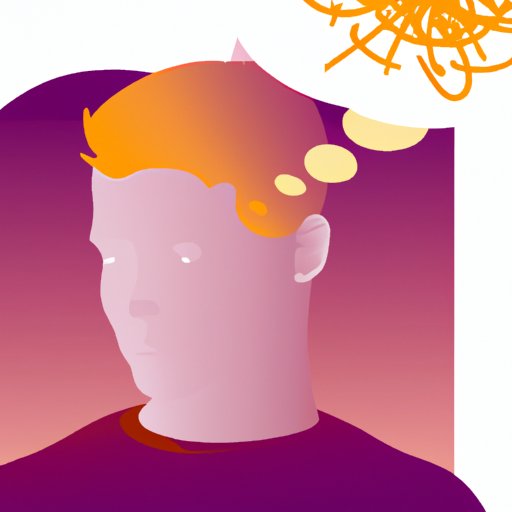
I. Introduction
When it comes to overall health, both physical and mental well-being are equally important. However, mental health has often been overlooked, leading to various misconceptions and a lack of understanding. Mental illness is a significant concern that affects millions of people worldwide. This article will focus on the most common mental illness that people face today, exploring its various aspects, including its definition, prevalence, signs, causes, and treatment options.
II. Exploring the Prevalence of Anxiety: The Most Common Mental Illness
Anxiety disorder is the most common mental illness that affects around 1 in 13 people globally. It is characterized by intense fear, apprehension, nervousness, and worry. People suffering from anxiety often experience physical symptoms such as rapid heartbeat, sweating, and tremors.
Some of the most common signs and symptoms of anxiety include irritability, restlessness, trouble concentrating, insomnia, and panic attacks. Anxiety can be caused by various factors such as high levels of stress, trauma, genetics, or a chemical imbalance in the brain.
Treatment options for anxiety may include therapy, medication, or a combination of both. Cognitive-behavioral therapy is often used to help patients manage their anxiety symptoms by identifying and changing negative thought patterns and behaviors. In some cases, medication such as anti-anxiety drugs can be prescribed to help control anxiety symptoms.
III. Understanding Depression: The Widespread Mental Health Condition
Depression is a disorder that affects a person’s mood and emotional state, causing feelings of sadness, hopelessness, and despair. It is a widespread condition that affects approximately 264 million people globally, according to the World Health Organization.
Some of the most common signs and symptoms of depression include difficulty sleeping, a loss of interest in activities, feelings of guilt or worthlessness, and thoughts of suicide. Depression can be caused by various factors such as a traumatic event, the loss of a loved one, or a chemical imbalance in the brain.
Depression can be treated through therapy, medication, or a combination of both. Psychotherapy is often used to help people cope with their depression symptoms by identifying negative thought patterns and behaviors. Medications, including antidepressants, may also be prescribed to help manage depression symptoms.
IV. Breaking Stigma: Shedding Light on The Most Common Mental Health Disorders
There are various misconceptions and stigmas surrounding mental illness that lead to people feeling ashamed or embarrassed to seek help. Mental health stigma refers to negative attitudes and beliefs towards people with mental illness. These negative attitudes can lead to discrimination and can affect a person’s ability to seek help.
To break the stigma, it’s essential to educate people on what mental illness is and what it isn’t. It’s also crucial to understand that mental illness is not a weakness, and seeking help is a sign of strength. Mental illness is a widespread condition that impacts people of all ages, races, genders, and backgrounds.
It’s essential to support and encourage people with mental illness and to provide access to resources and services that can help them manage their symptoms. People with mental illness should be treated with the same respect and dignity as people with physical illness.
V. The Many Faces of Mental Illness: An Insight Into the Widespread Condition
Aside from anxiety disorder and depression, other common mental illnesses include bipolar disorder, schizophrenia, and post-traumatic stress disorder (PTSD). These conditions have various signs and symptoms and are caused by different factors.
Bipolar disorder is a condition characterized by periods of depression and mania, which leads to extreme changes in mood, behavior, and energy levels. Schizophrenia is a severe mental disorder that affects a person’s ability to think, feel, and behave clearly. PTSD is a mental health condition that occurs after experiencing or witnessing a traumatic event, such as a natural disaster, violence, or military combat.
Treatment options for these mental illnesses may include medication and psychotherapy, depending on the severity of the condition.
VI. An Overview of Mental Health: Analyzing the Most Common Mental Illnesses
The prevalence of mental illness is high, affecting approximately one in four people worldwide. The most common mental illnesses include anxiety disorder, depression, bipolar disorder, schizophrenia, and PTSD.
There are various types of mental illnesses, each with unique signs, symptoms, and causes. Mental illness can have a significant impact on a person’s life, leading to disruptions in work, school, and personal relationships.
It’s essential to provide access to information, resources, and support for people with mental illness. Access to effective treatment and medication is a cornerstone of proper mental healthcare.

VII. Revolutionizing Mental Healthcare: Tackling the Most Common Mental Health Concerns
Mental healthcare has evolved dramatically over the years, and new and innovative approaches to treatment are continuously emerging. These approaches include Cognitive-behavioral therapy, mindfulness-based therapy, and alternative therapies such as yoga and meditation.
While medication is still an effective treatment option, mental healthcare providers are increasingly looking for alternative treatment options that are less reliant on medication. This approach includes psychotherapy with a focus on talk therapy, where people can explore their thoughts and emotions in a supportive environment.
It’s essential to continue research into mental health treatments and explore ways to make them accessible to people who need them most.
VIII. Living with Mental Illness: Real Stories of Dealing with The Most Common Conditions
Mental illness affects people differently, and no two stories are the same. It’s essential to listen to people’s experiences and understand what living with mental illness is truly like.
People who live with mental illness can provide valuable insight into how they manage their condition, what works for them, and what doesn’t.
It’s essential to provide resources and support for people with mental illness, such as peer support groups, online forums, and counseling services. By sharing stories and providing support, we can break the stigma surrounding mental illness and ensure that people with mental health disorders receive the care and support they need.
IX. Conclusion
In conclusion, mental illness is a prevalent condition that affects millions of people worldwide. Anxiety disorder and depression are the most common mental illnesses people face today. The stigma surrounding mental illness continues to affect the lives of people with mental health disorders.
To break the stigma, it’s essential to educate people about mental illness and provide access to resources and services that can help manage symptoms. It’s crucial to continue research into mental health treatments and explore ways to make them accessible to all who need them.
With the right support, people with mental illness can manage their condition and live a fulfilling life.





